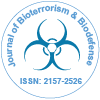开放获取期刊获得更多读者和引用
700 种期刊 和 15,000,000 名读者 每份期刊 获得 25,000 多名读者
索引于
- CAS 来源索引 (CASSI)
- 哥白尼索引
- 谷歌学术
- 夏尔巴·罗密欧
- 打开 J 门
- Genamics 期刊搜索
- 学术钥匙
- 期刊目录
- 研究圣经
- 中国知网(CNKI)
- 乌尔里希的期刊目录
- 参考搜索
- 哈姆达大学
- 亚利桑那州EBSCO
- OCLC-世界猫
- SWB 在线目录
- 普布隆斯
- 日内瓦医学教育与研究基金会
- 欧洲酒吧
- ICMJE
有用的链接
开放获取期刊
分享此页面
抽象的
Low Level of Awareness in Biosafety and Biosecurity among Professionals in Uganda: A Potential Risk in the Dual-Use Dilemma
Halid Kirunda1* and Maxwell OtimOnapa2
Disease diagnosis, and analysis or manipulation of both human and animal samples, expose scientists and practitioners to disease causing agents and toxins. In situations of poor awareness of biosecurity, the same samples can easily be accessed by persons with wrong intentions or misused by the same scientists or practitioners (dualuse). In Uganda information required to minimize the global challenges of biosafety and biosecurity has been largely lacking. The current study assessed the level of awareness and existence of procedures, regulations, laws and policies on biosafety and biosecurity among institutions in the different sectors, professions and regions across the country. Results showed that sector, profession and region were each a predictor for nine of the assessed variables. Among the most striking was that profession significantly influenced (χ2=49.0) the opinion that institutional measures to prevent or prohibit production, stockpiling, retention or unimpeded access to pathogenic agents and biological toxins existed. Professionals (veterinary scientists and laboratory technologists) in animal health research had reduced odds of holding this opinion (OR=0.2, 95% CI: 0.05-0.87) compared to their counterparts in public hygiene. Scientific establishments in eastern (OR=0.3, 95% CI: 0.17-0.7, p<0.01), northern (OR=0.4, 95% CI: 0.17-0.71, p<0.01) and western (OR=0.3, 95% CI: 0.16-0.51, p<0.01) regions were less associated with professionals trained in biosafety and biosecurity compared to central Uganda. Professionals in wildlife conservation, medical, human health research, public hygiene and crop extension services were 9.5, 7.0, 5.7, 5.4 and 4.0 times, respectively, more likely to consider Uganda’s disease monitoring system as adequate compared to those in veterinary services sector. We conclude that there is inadequate level of awareness on laboratory biosafety and biosecurity among professionals in the country. There is need for raising awareness and training of relevant professionals and formulation of measures, policies, regulations and laws to help prevent exposure to and misuse of dangerous biological agents and toxins in Uganda.

 English
English  Spanish
Spanish  Russian
Russian  German
German  French
French  Japanese
Japanese  Portuguese
Portuguese  Hindi
Hindi